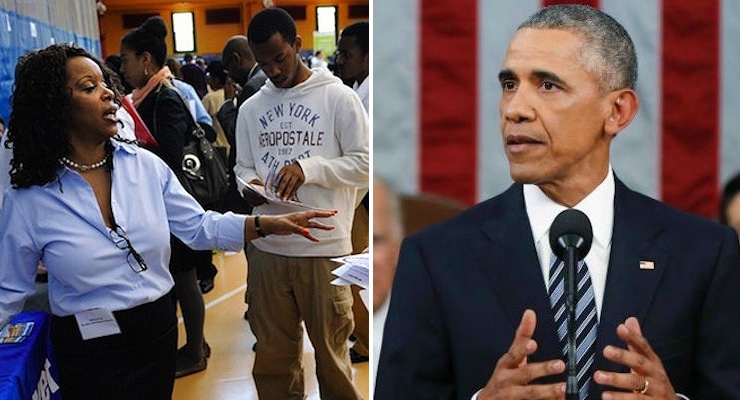

Job seekers, left, applying for weekly jobless benefits at a state-run job fair. President Barack Obama, right, delivers his final State of the Union address on Tuesday, January 12, 2015.(Photos: Reuters/Evan Vucci/Pool)
What’s the most important economic statistic to gauge a society’s prosperity? I often use per-capita economic output when comparing nations.
But for ordinary people, what probably matters most is household income. And if you look at the median household income numbers for the United States, Obamanomics is a failure. According to the Census Bureau’s latest numbers, the average family today has less income (after adjusting for inflation) than when Obama took office.
In an amazing feat of chutzpah, however, the President is actually arguing that he’s done a good job with the economy. His main talking point is that the unemployment rate is down to 4.7 percent. Yet, as discussed in this Blaze TV interview, sometimes the unemployment rate falls for less-than-ideal reasons.
[brid video=”40829″ player=”2077″ title=”Dan Mitchell Commenting on Falling Labor Force Participation”]
Since I’m a wonky economist, I think my most important point was about long-run prosperity being dependent on the amount of labor and capital being productively utilized in an economy. And that’s why the unemployment rate, while important, is not as important as the labor force participation rate.
Here’s the data, directly from the Bureau of Labor Statistics.
As you can see, the trend over the past 10 years is not very heartening.

To be sure, Obama should not be blamed for the fact that a downward trend that began in 2008 (except to the extent that he supported the big-government policies of the Bush Administration).
But he can be blamed for the fact that the numbers haven’t recovered, as would normally happen as an economy pulls out of a recession. This is a rather damning indictment of Obamanomics.
By the way, I can’t resist commenting on what Obama said in the soundbite that preceded my interview. He asserted that “we cut unemployment in half years before a lot of economists thought we could.”
My jaw almost hit the floor. This is a White House that promised the unemployment rate would peak at only 8 percent and then quickly fall if the so-called stimulus was approved. Yet the joblessness rate jumped to 10 percent and only began to fall after there was a shift in policy that resulted in a spending freeze.
In effect, the President airbrushed history and then tried to take credit for something that happened, at least in part, because of policies he opposed.
Wow.
One final point. I was asked in the interview which policy deserves the lion’s share of the blame for the economy’s tepid performance and weak job numbers.
I wasn’t expecting that question, so I fumbled around a bit before choosing ObamaCare.
But with the wisdom of hindsight, I think I stumbled onto the right answer. Yes, the stimulus was a flop, and yes, Dodd-Frank has been a regulatory nightmare, but ObamaCare was (and continues to be) a perfect storm of taxes, spending, and regulatory intervention.
And even the Congressional Budget Office estimates it has cost the economy two million jobs.





John Pierce / June 13, 2016
Very accurate points.
How can an economic program possibly be considered a success when the economy is so fragile that the Fed is unable to lift interest rates after 7-1/2 YEARS at the near-zero rate? It cannot. The economy is fragile and declining, or at best stagnant, for almost all Americans that are not part of the top one percent.
But the one percent are in control, and things are proceeding exactly as they prefer, with wealth concentration increasing significantly from already high levels.
/